Macs are reliable machines but on the rare occasions, they may start acting strangely for no obvious reason. Your Mac’s entering sleep unexpectedly, the battery doesn’t charge properly, your keyboard isn’t responding normally, Wi-Fi and Bluetooth refuse to work — these symptoms might mean that PRAM and SMC reset is necessary.
But before we show you how to reset MacBook’s PRAM and SMC, let us explain what SMC and PRAM mean and what problems resetting may solve.
What are PRAM/NVRAM and SMC?
I have a MAC PRO 3,1 8-Core that all USB ports stopped working, I tried the SMC reset, and it does not work, PRAM and NVRAM reset dont work since the USB ports don't work, I dont have a wireless keyboard or mouse (bluetooth), and even if I had I cant configure them since I cannot use the mouse or Keyboard. So basically stuck. This video will show you how to Fix your MacBook by resetting SMC System Management Controller. This process can fix many issues with your MacBook.
PRAM (Parameter Random Access Memory) stores vital system information, including display settings, the speaker volume, time zone settings, etc. PRAM is powered by the internal battery, that’s why the information is not lost when you turn your Mac off.
Occasionally PRAM gets corrupted and needs to be restored to fix problems that have developed.
Reset your SMC on iMac, Mac Pro, Mac Mini. Note that performing an SMC reset for a non-portable Apple device is different for portable devices. As with MacBooks and portable devices, however, the procedure is straightforward and any problems with SMC on a desktop Mac. Follow these steps to reset the SMC on an iMac, iMac Pro or Mac mini. Shut down the computer. Unplug the power cord. Wait 15 seconds. Reattach the power cord. Yet another component of your Mac’s hardware that stores crucial settings is the System Management Controller (SMC), a circuit that deals with power management, temperature.
Note that modern Macs no longer use PRAM, instead they use something called NVRAM (non-volatile RAM). NVRAM serves approximately the same purpose as PRAM but its corruption is fairly uncommon. Nevertheless, it doesn’t hurt to reset it if your Mac starts acting weird — NVRAM reset is fast and harmless.
SMC (System Management Controller) is responsible for important physical aspects of Intel-based Mac computers. SMC manages a lot more interesting things than PRAM, such as fans, lights, power, and system performance. Fortunately, it’s easy to reset your SMC to its original factory settings and fix problems on your Mac.
When you may need to reset PRAM and SMC on MacBook
Resetting PRAM and SMC is a way out if your Mac starts acting strange. You may consider resetting either PRAM or SMC depending on the problem you face, or try to reset them both.
Resetting PRAM is particularly useful if you’re having the following types of problems:
- Wrong date, time or time zone
- Strange mouse scrolling speed
- A question mark icon appears at a startup
- Display resolution won’t change
- Sound volume won’t stick
Consider to reset SMC on MacBook Pro or any other Mac computer if you experience one or more of these issues:
- Unexpected shutdowns
- Battery isn’t charging properly
- Power button doesn’t function well
- External devices are not recognized
- Fans running extremely fast and loud
- USB ports and Bluetooth are not working
- MacBook isn’t responding to the lid opening or closing
- Keyboard backlight doesn’t work
- Display brightness functionality isn’t working right
Note: Resetting PRAM and SMC is usually safe, but that’s not a guarantee. Make sure to try basic rebooting and other troubleshooting steps before you begin. You can use a utility like CleanMyMac X to put things right on your Mac. Its Maintenance module gives you direct access to all sorts of Mac optimizing goodies. Run maintenance scripts with CleanMyMac to quickly optimize your system’s performance.
How to reset PRAM/NVRAM
Whether your computer uses PRAM or NVRAM, the steps for resetting are the same. So do the following to reset PRAM on Mac:
- Turn off your Mac.
- Press the power button.
- Immediately press the Command+Option+P+R keys.
- Hold the keys until your Mac restarts and you hear the startup sound.
- Release the keys.

Smc Reset Mac Pro 5 1
After resetting PRAM/NVRAM, you may need to adjust some of your Mac’s settings, such as time, date, sound volume, or time zone.
If you’re still having problems with your Mac after resetting PRAM, consider resetting its SMC.
How to reset SMC
Before resetting your Mac’s SMC, you need to determine whether its battery is removable. That’s because the process of resetting SMC for Macs that have a non-removable battery is quite different. Plus, there are some differences for Mac desktop computers.
Resetting SMC on MacBook, MacBook Pro, and MacBook Air
If the battery is removable:
- Turn off your Mac.
- Remove the battery.
- Press the power button and hold it for a few seconds.
- Reinstall the battery.
- Press the power button to turn on your Mac.
If the battery is non-removable:
- Shut down your Mac.
- Press Shift+Control+Option on your keyboard and press the power button at the same time.
- Hold these keys for 10 seconds.
- Release the keys.
- Press the power button again to turn on your Mac.
Smc Reset Mac Pro 2008

What Is Power On Reset
Resetting SMC on iMac, Mac Pro and Mac Mini
- Shut down your Mac.
- Unplug a power cord.
- Wait 15 seconds.
- Plug the power cord in.
- Wait several seconds and turn on your computer by pressing a power button.
That’s it. Really. Lots of steps for something that won’t take so much of your time.
Now that you have reset your Mac’s SMC and PRAM, your computer should be back to operating as you expect. However, if you still experience the sluggish performance, make sure to check a comprehensive guide on “How to Speed up Mac”.
Thanks for reading and stay tuned for more tips and tricks!
These might also interest you:
